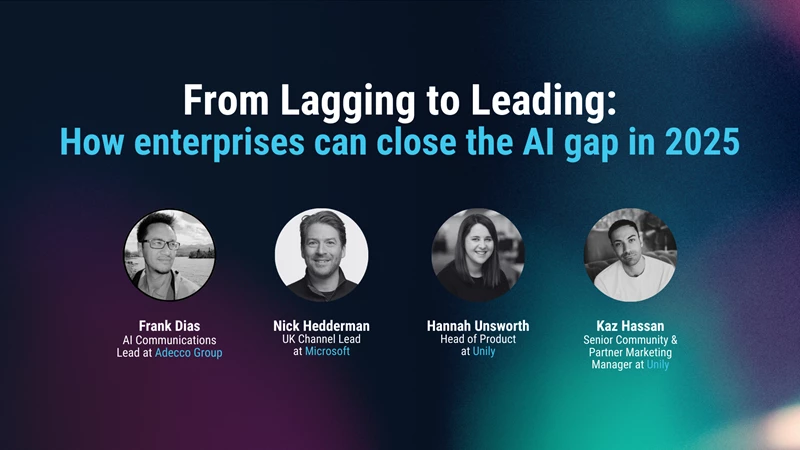IT trends for employee experience visionaries
Today’s business leaders understand that success starts with an engaged and empowered workforce. Transforming the employee experience to better align and activate employees has become a major focus, and every department is being called on to play its part. IT leaders have a big role to play and those who answer the call stand to shine in an era that will be characterized by the success or failure of the digital workplace. Here’s what IT leaders need to know to ride the incoming wave.

The employee experience opportunity for IT
From their beginnings as functional support, IT teams have become a powerful division, vital for customer and employee support and engagement. Today, the enterprises that win are those that strive to get the best results out of the IT opportunities that impact employee experience (EX).
Gallup shows that the best-performing companies of the moment are those heavily invested in customer experience (CX), allowing customers to quickly and easily engage through technology. In fact, it looks like CX is set to improve for the first time in three years as a result of generative AI advancements. As large IT teams continue to use this new tech to improve customer experiences ahead of competitors, the gap between CX and EX becomes ever wider. This makes it increasingly difficult for employees to do their jobs productively or effectively, ultimately preventing them from providing the best experience to customers.
It’s no wonder forecasts including Forrester show that employee experience (EX) will be the most influential opportunity for enterprises in 2024. And there are plenty of ways to make the most of it.
Now for the bad news. Many teams in charge of enhancing EX are set to struggle due to a shortage of funding and a lack of focus. According to Forrester, 66% of technology decision-makers say they will invest in EX/human capital management software next year. However, those investments won’t reach their full potential. Most will miss the mark by prioritizing efficiency over improving the actual experience for employees. This creates an opportunity for forward-thinking enterprises to race ahead with EX while others stay in the slow lane.
So which IT trends should you be looking out for to ensure your enterprise is equipped to deliver the best EX in 2024? Let’s take a look.
Top trends for EX-focused IT leaders in 2024
1. Looking beyond old collaboration tools
For a long time, enterprises have turned to technology to solve collaboration challenges. Before mass hybrid working, those collaboration needs were met with tools like Microsoft 365, which allowed for improved document collaboration, video conferencing, team-based chats, and shared to-do lists. But today the collaboration barriers are different. In the world of flexible working, the big challenges center around creating the conditions for cross-functional working and borderless knowledge exchange. How do we create the moments for true collaboration to happen when employees are working in such disparate ways?
There is a tendency for IT to look to existing technology to plug these gaps, which leads to tech like Microsoft 365 being used for functions it wasn’t necessarily intended for. The result is a clunky collaboration experience for employees that ultimately damages business performance.
Understanding that only 11% of business leaders expect employees to return to the office full-time, now is the time for businesses to take a step back and critically analyze the collaboration needs of the workforce. Zooming out to think about collaboration strategy as a whole will allow IT to evaluate solutions against critical needs. Instead of automatically turning to existing platforms that were designed around old, office-based ways of working, IT has an opportunity to drive meaningful transformation by considering alternative solutions with the potential to truly create the conditions for collaborative innovation.
2. Tune out noise
Most businesses are striving for better communication with employees. On average, employees receive over 120 emails per day and, as reported by Forbes, 89% of employees said that sorting through unopened emails and Slack or Microsoft Teams messages was one of the worst parts of remote working. There’s a mismatch between employees pressuring organizations to reduce digital noise and give them more control, while leadership teams focus on attempting to bring employees up to date with company information.
IT teams are integral to solving this misalignment. There’s a huge opportunity for tech to give employees control over notifications, ensuring higher job satisfaction and retention, while also increasing the effectiveness and efficiency of communication from leaders - through simplifying comms within the business.
One solution may be to consolidate channels of communication into a simpler experience for employees. Workers need to be able to receive notifications through one app - bringing together email, Teams, Slack, intranet, and other channels. This also includes allowing employees to choose how they receive their communications, for example, social notifications via an app and meeting notifications via email.
We currently have the most diverse workforce in terms of age. There are five generations working together, all with different expectations of technology. It’s vital that EX tech keeps up with this, especially when it comes to channels of communication. Older workers have used email for decades, while Generation Z has grown up using chat apps almost constantly. Some employees may also prefer to receive non-urgent notifications in an app they check less often, while important communications are kept to email. Employees need to be empowered to choose their own ways of working, as we move away from top-down communication.
3. EX tech = CX tech
EX tech has long been thought of as simply a collection of tools that enable communication and allow employees to get their jobs done. In fact, the best examples of EX tech pay their value forward, supporting the delivery of better customer experiences. EX tech is CX tech. And in 2024, we expect to see businesses shifting to a much more holistic view of the two.
Investment into digital employee experience initiatives, if done correctly, should be conceived as an investment into improving customer experience in equal measure. The scoping of new DEX investments should include consideration for how this will ultimately lead to better customer experiences. Afterall, employees who are armed with simple access to business knowledge and training are empowered to deliver against customer expectations, whether they’re interacting with customers directly or working behind the scenes to develop products and solutions that meet customer needs.
A prime example of this ideology in action can be found in the luxury travel brand, Kerzner International. With hundreds of resorts all over the world and employees working across different frontline roles to create everlasting memories for guests, Kerzner understood that to deliver the exceptional customer service their brand reputation is built on, they needed to change the way they engage and enable their employees.
By choosing to develop an employee app that connects their people directly to business knowledge, training resources, and peer-to-peer information sharing, Kerzner has created a workforce of informed brand ambassadors who can easily find the answer to any customer query. The company has been able to prove a direct correlation between app adoption and employee engagement scores, with employees using the app claiming that they are better able to serve customers and feel a greater attachment to the brand.
Instead of continuing down the path of investing in the latest, greatest CX tech, IT should pause and think about how investment in better EX tech can lead to a better result for all parties. There is a danger that if that CX/EX gap continues to grow - particularly as chatbots become smarter - customers could end up knowing more about a company and its products than employees do.
4. Responsibility to communicate about AI
There’s no way to talk about IT trends for 2024 without mentioning AI. But, as IT well knows, scrambling to use AI for AI’s sake is not enough to beat the competition and improve customer experience. As an example, the rise in AI chatbots has been helpful for some customer experiences, while leaving others wanting more meaningful people interactions. This brings us back to the need to spend time uncovering the real problem and trying to improve and innovate, rather than using shiny new technologies to build something that doesn't quite solve the issue.
Responsibility for communicating AI to employees has fallen to IT teams. Without proper communication, employees often fumble with AI tools, whether through rogue use of ChatGPT or hasty acquisition of new tech. Businesses end up with shadow IT, where different departments acquire and use different technologies to solve problems quickly, leading to the proliferation of the tech stack. With AI, this leaves you vulnerable to gaps in security, and the potential risk of compromising organizational data or mistakenly uploading confidential documents. It also leads to non-strategic use of technology. Without thought into how these tools work together, employees can be left feeling overwhelmed and with gaps in awareness of what’s available.
"One-third of all respondents say their organizations are already regularly using generative AI in at least one function."
In 2023, we’ve seen two solutions to this. Companies putting out policies to lock down AI and not allowing employees to use it, and others who haven’t been able to create policies because of disagreements at the leadership level.
HR, IT, and teams responsible for internal communications need to work together to build awareness of what AI is, how the business is looking to use it, and what employees should and shouldn’t be doing with it. Without a clear communication strategy, we see some employees fearing for their jobs, others unable to do their job as effectively without AI, and differing opinions and worries throughout the business.
A brilliant example of IT partnering with internal communications (IC) can be found in the airline industry, where one company tasked employees with distinguishing between AI-generated and non-AI-generated clips of pop singer Miley Cyrus. Employees were drawn into the AI discussion with an approachable campaign that encouraged the broad population to get interested in the company's AI policies and resources. This dynamic, engaging approach demonstrates the magic that energetic IC brings to the table.
The longer AI policies are left, the more the problem builds as the workforce becomes more AI dextrous and learns to use tools further from the company’s policies. There’s also the risk of creating a gap in the workforce between Gen Z, who are entering the workforce as generally AI dextrous, and older generations, who have fulfilled their responsibilities without AI for decades. The risk is that younger employees can solve problems more efficiently and armed with more knowledge, while older employees may get left behind.
5. More mobile-first EX tech strategies
A majority of C-suite executives believe connecting frontline employees is critical to success, and something which has long been overlooked. This omission is partly caused by a desktop-first approach to EX, which naturally prioritizes office workers over those on the frontline. In 2024, we can expect to see this addressed with the introduction of more mobile-first EX tech strategies.
In the current landscape, we’re seeing the launch of mobile tech before desktop versions. There's a visible pivot towards acknowledging the significance of mobile interfaces and their relevance in meeting the needs of a broader range of employees, including those on the frontline.
The shift to hybrid work as well as the introduction of Gen Z to the workforce are other key factors to thank for this change. Organizations are increasingly moving away from viewing the office environment as the center of business.
Our IT trends of 2023 article suggested the rise of the superapp, and we can expect to see it mature in 2024. The superapp is a one-stop-shop allowing users to multitask in the same app. Think the Uber app, which contains taxis, Uber Eats, trains, and flights in one place. In fact, according to CIO.com, switching between apps is proven to be harmful to productivity. The companies that win will limit the amount of switching needed, keeping everything in one centralized place, which is easily accessible to everyone through mobile.
6. Collaborative innovation
Gen Z is remarkably tech-savvy. They’re early adopters who know what they want from tech, and have insights IT teams can tap into. This knowledge means they are able to articulate their ideas in a way that is valuable for the business. Enterprises should be encouraging their participation in the conversation, and the most forward-thinking IT teams will be capitalizing on their knowledge and ideas.
Combining the know-how of this new generation of employees with collaboration technology like ideation portals and crowdsourcing mechanics will allow better ideas to gain traction throughout the business. Ideas can be tested quickly and integrated or discarded by employees who really understand the technology, helping close the EX/CX gap with novel digital solutions.
Importantly, getting Gen Z involved is a potential solution to the struggle to engage them, a challenge faced more than with any other generation. 54% of Gen Z find that they are not engaged at work, according to Gallup. This generation is also newer to the workforce and less likely to be in positions responsible for high-level decision-making, giving organizations that engage them a broader and more diverse range of ideas and thinking.
Generation Z employees want to make change happen, and have high expectations of tech integrations, having grown up with compatible technology solutions. They place emphasis on working together with IT teams to make changes and move forward. And the IT teams that work with them will have built tools with the workforce of the future - helping them to stay ahead of the many tech changes. By encouraging collaboration, employers can ensure Gen Z employees feel a part of their organization, as well as benefiting from a wider range of contributions.
7. Using AI coders to fail-fast test new widgets
With employee ideation tapped into as a means to better cater to evolving workforce needs, the question then becomes, how can IT create space to develop and test some of the most popular ideas coming through?
Rigid processes and a lack of resources have historically held IT teams from being able to develop requested widgets at the pace they’re asked for. The introduction of AI to coding means these teams now have the resources to build widgets at a much faster pace, using a fail-fast strategy to build, test, and further develop or discard widgets. IT has the opportunity to capitalize on AI and collaborate with employees on building the best possible EX tech.
"Visionary tech execs will seize this opportunity to strategically realign IT resources to unlock the immense creative potential within their teams — not just among developers but across all IT roles. They will leverage this AI moment to create an environment that promotes innovation, interdisciplinary teamwork, continuous learning, and alignment with the broader business strategy."
Be the changemaker your enterprise needs
As we approach a challenging year of economic uncertainty, those enterprises that choose to invest in an inside-out approach that recognizes the ROI of DEX spending will be well-placed to rise to the challenge. CIOs and CTOs have a huge opportunity to drive business outcomes through digital employee experience investment. And for any business leaders or counterparts who still need convincing, it can’t hurt to remind them that at the current rate, employee disengagement is costing the global economy 9% of the GDP. The changes you make at your organizations really could change the world!






















